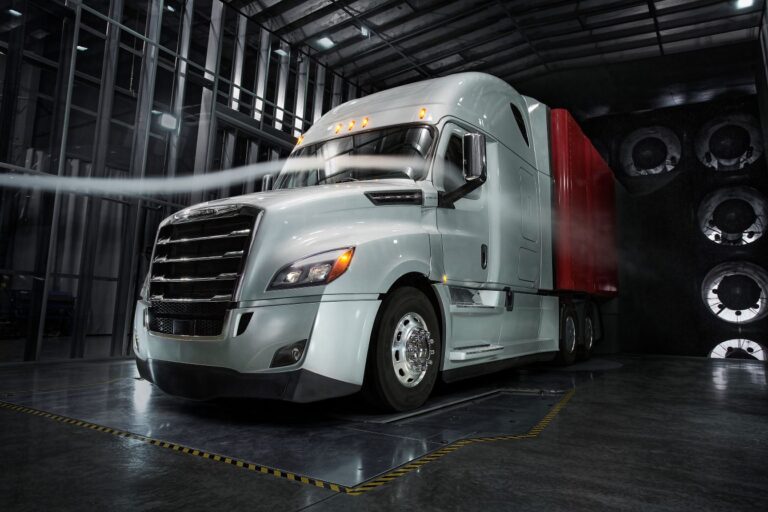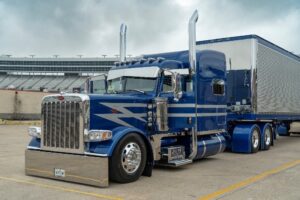As Februarys go, the second month of 2024 wasn’t a bad month for U.S. sales of new Class 8 trucks. Manufacturers reported selling 17,619 of them, according to Wards Intelligence. That makes it the third-highest February in the past decade.
February was the seventh consecutive month in which sales were down from the same month a year earlier. In February 2023, when sales were still on the upswing, 20,136 new trucks were sold. For the year to date (which includes only two months of reports), sales are running 9.6% behind last year’s pace.
Sales of new trucks is often viewed as an indicator of where the freight market is headed. When carriers are confident they’ll be able to earn a profit in the coming months, they buy new trucks. When the market points upward, many company drivers with an entrepreneurial spirit buy trucks and become owner-operators, starting new carriers in hopes that growing business will one day have a “started with a single truck” story as many larger carriers do today.
But this time, there’s a catch.
The government has issued new fuel mileage and emissions standards for model year 2027. Those new standards include something else — a requirement that warranties be lengthened to help buyers have confidence in vehicles built with new technology. That technology (along with the extended warranties the manufacturers must fund) is expected to drive the price of trucks up by $25,000-$30,000 each.
Like they did in 2006 and again in 2009, carriers are considering buying more trucks built before the new standards (and higher pricing) go into effect. The closer the calendar gets to the production of 2027 model-year trucks, the more pre-buying is expected. Some of that will start with the introduction of the 2025 models later this year.
The problem is that the industry already has a capacity problem: There are too many available trucks to haul too few available loads, increasing competition for freight and keeping rates at levels that make it difficult to sustain a trucking business. For freight rates to improve, the number of available trucks needs to go down, not up, unless something happens to cause the economy to greatly increase production. Pre-buying trucks now only increases capacity.
According to a blog post by ACT Research, February U.S. orders for new Class 8 trucks were at 17,213, a 32% increase over February 2023 orders.
A part of that increase is on the vocational side, according to ACT President and Senior Analyst Kenny Vieth.
“The vocational market remains strong, particularly in the US, where nearshoring and government programs have spurred investment,” Vieth said.
One reason for the vocational increase is nearshoring, a practice that’s creating a boom in the Mexico market as manufacturers and warehousers move operations from Asian locations, particularly China, closer to U.S. markets. Doing so takes advantage of lower-cost labor and more favorable tariffs available in Mexico and saves shipping costs as ships from Asia load and unload in Mexican ports, bypassing the delays and expense of U.S. west coast ports. For the first time in more than 20 years, U.S. imports from Mexico have surpassed those from China. More trucks will be needed to handle the increase in imports.
Another stimulant for the vocational side is the $1 trillion infrastructure bill passed in 2021. The government money available for roads, bridges and other construction projects will stimulate sales of trucks to haul building materials such as asphalt and concrete.
Vieth also believes private fleets are responsible for a portion of the sales increase.
“With February orders underscoring the ongoing above-demand-level trend in an otherwise overcapacitized U.S. market, further corroboration of evidence leads us to believe that prebuying is being driven by private fleets,” he said.
The reason, he explained, is that private fleets tend to have longer trade cycles, and because they’re hauling their own products they aren’t as dependent on freight rates. Since those private fleets sometimes obtain backhauls on the freight market, however, those trucks DO have an impact on capacity.
Buyers ordered 20,500 trailers in February, preliminary estimates from ACT showed, down 21% from last February but still robust.
On the used truck side of the market, retail sales volumes experienced a 15% increase in February compared to January and a 32% increase compared with February of 2023. Because more used trucks are available, the price of the average used truck sold in February was 19% lower than it was a year ago. The average miles on a used truck sold in February was 10% lower than a year ago and its age was 5% newer.
“The gain was stronger than expected as sales are typically still emerging from the winter freeze this time of year,” said Steve Tam, ACT vice president and senior analyst.
While more used trucks are available and cost less, on average, the increased cost of credit due to higher interest rates plus more restrictive loan policies will keep some potential buyers from taking advantage.
The sales performance for individual truck manufacturers varied.
Freightliner sold 6,027 Class 8 trucks on the U.S. market in February, down 27.7% from January and down 18.2% from February a year ago.
Volvo sales increased by 50.5% over January with sales of 2,142 but were down 9.5% from February 2023.
International reported U.S. Class 8 sales of 1,825 for February, down 3.1% from January and down 35.5% from February 2025.
The PACCAR companies remained fairly constant for the month. Kenworth reported sales of 2,791, up 12.3% from January but down 1.8% from last February. Peterbilt’s 2,916 sold topped January’s total by 8.2% and was 2.6% better than February 2023 sales.
Mack Truck reported sales of 1,104, up 29% from January but down 17.9% from last February.
Western Star sold fewer than anyone else at 814 units, down 9.7% from January but 52.4% better than February 2023.
For the year to date, 39.7% of new, Class 8 trucks sold on the U.S. market have been Freightliners, followed by Peterbilt at 15.5%, Kenworth at 14.6%, International at 10.2%, Volvo at 9.8%, Mack at 5.4% and Western Star at 4.7%.
Cliff Abbott is an experienced commercial vehicle driver and owner-operator who still holds a CDL in his home state of Alabama. In nearly 40 years in trucking, he’s been an instructor and trainer and has managed safety and recruiting operations for several carriers. Having never lost his love of the road, Cliff has written a book and hundreds of songs and has been writing for The Trucker for more than a decade.








